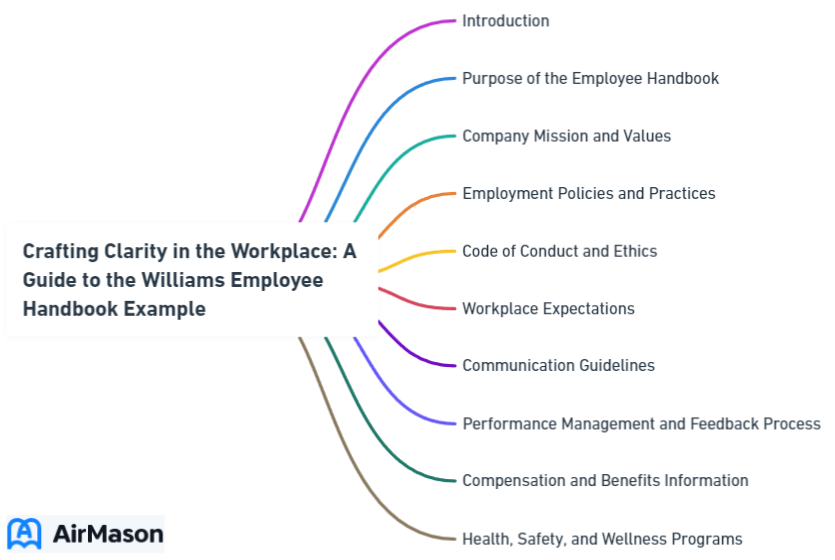
In search of a ‘williams employee handbook example’? We provide you with a no-fluff, direct outline of the handbook’s structure and essential policies. Discover how Williams articulates its workplace culture and regulations, a vital touchstone for developing or refining your own employee guide.
Key Takeaways
- The Williams Employee Handbook is a comprehensive resource for employees, clearly outlining company policies, employee benefits, rights and responsibilities, and guidelines for various workplace situations including harassment and discrimination prevention.
- Regular updates and clear language are integral to the handbook’s effectiveness, ensuring legal compliance, relevancy, and accessibility for employees.
- In addition to standard policies, the handbook includes detailed information on the responsible use of social media and technology, reflecting the company’s commitment to maintaining a secure and respectful digital environment.
Fortune 500 Companies Employee Handbook
Welcome to the comprehensive Fortune 500 Companies Employee Handbook, a valuable resource designed to guide you through your professional journey within our esteemed organization. This handbook serves as a crucial reference, outlining policies, procedures, and expectations that define our workplace culture. As you embark on your career with us, familiarize yourself with the contents herein to ensure a seamless integration into the dynamic environment of Fortune 500 companies. From corporate values to employee benefits, this handbook encapsulates the essence of what it means to be part of our esteemed workforce. Embrace the opportunities and responsibilities outlined in this document, and let it be your compass in navigating a successful and fulfilling career with us.
The Williams Employee Handbook: A Comprehensive Overview
The Williams Employee Handbook serves as a mentor, guide, and reference for employees, with a particular focus on the company’s administrative and support staff. This comprehensive handbook houses valuable information about the company’s essential workplace policies, including:
- Code of Conduct
- Anti-Harassment Policy
- Attendance and Punctuality
- Dress Code
- Employee Benefits
- Performance Evaluation
- Grievance Procedure
This handbook assists employees in understanding their position within the organization and provides guidance on how to navigate various workplace situations.
The handbook is systematically distributed to grant employees access to crucial company policies and guidance, including employee benefits. In essence, it’s a compass that directs employees through the intricate labyrinth of workplace policies, ensuring that they are always on the right path.
Importance of an Employee Handbook
Providing clear guidelines and expectations for both employees and the employer makes an employee handbook indispensable. It also serves as a valuable resource for addressing any workplace issues or questions that may arise. First and foremost, it is a vital instrument for legal compliance, often requested in government employment audits and employment lawsuits. Keeping it updated can prevent penalties, damages, and exposure to claims and lawsuits.
By spotlighting Equal Employment Opportunity and anti-discrimination policies, an employee handbook contributes significantly to fostering a positive workplace environment. It outlines employer commitments and benefits, providing guidance on employee-supervisor interactions.
It also establishes a framework for Employee Acknowledgment, ensuring that employees have received, read, and comprehended the handbook, and consent to adhere to its provisions.

Williams Employee Handbook: Key Features
With its comprehensive nature, the 69-page Williams Employee Handbook offers in-depth guidelines for staff recruitment, clarifying employee rights and responsibilities. It is geared towards providing guidance and information to administrative and support staff, ensuring clarity on their rights and responsibilities.
This handbook covers legal rules related to general antitrust and competition law principles, background check policies, compliance with applicable rules and regulations, and restrictions on trading Williams securities. Distinct employment policies in the handbook encompass the Employee Assistance Program (EAP), Dependent Tuition Grant, Tuition Benefit, Reduced Fee Policy for Williams Courses, Rental Housing Program, and Non-Discrimination, Harassment, and Sexual Misconduct Policy.
Essential Sections of the Williams Employee Handbook
The Williams Employee Handbook is organized into the following key sections:
- Company policies
- Employee rights and responsibilities
- Workplace safety
- Health regulations
- Guidance for administrative and support staff
Each of these sections is crucial for employee understanding. For instance, the company policies and support details section is specifically designed for administrative and support staff, ensuring the clear communication of essential rules and regulations. The handbook also covers employee benefits in detail, ensuring that all team members are well-informed of their entitlements.
Workplace Policies and Procedures

The Williams Employee Handbook conveys workplace policies and procedures intending to provide administrative and support staff with guidance and information. The handbook ensures comprehension and adherence by providing comprehensive information in a detailed document and by evaluating all reported allegations of non-compliance.
The Williams Employee Handbook stands out by encompassing distinctive or groundbreaking workplace policies. These policies are not just rules set in stone; they are a commitment to creating a harmonious and productive work environment.
Employee Benefits

Like many companies, Williams offers benefits, including compensation, professional growth opportunities, and all-encompassing packages that cover various allowances and insurances. Williams goes a step further by conveying their employee benefits in the handbook through the Employee Assistance Program (EAP). This program provides confidential and voluntary counseling referral services at no charge to the employees, ensuring that they have clear and accessible information about the benefits available to them.
In comparison to its industry competitors, Williams stands out with its comprehensive benefits. These include:
- A pension
- 401k
- Above industry standard paid time off (PTO)
- Comprehensive packages with spending and saving accounts
- Income protection
It’s clear that at Williams, the employees’ wellbeing is a priority.
EMCOR Group Employee Handbook Example
In the EMCOR Group employee handbook example, a comprehensive set of guidelines and policies is meticulously laid out to ensure a transparent and harmonious work environment. The EMCOR Group employee handbook serves as a crucial reference for all employees, providing insights into the company’s values, code of conduct, and expectations. This handbook exemplifies EMCOR Group’s commitment to fostering a culture of professionalism, diversity, and continuous growth. By adhering to the principles outlined in the EMCOR Group employee handbook, employees contribute to a workplace that prioritizes integrity, collaboration, and excellence. This document stands as a testament to EMCOR Group’s dedication to creating a positive and supportive workplace for its diverse workforce.
Discrimination and Harassment Prevention
Preventing discrimination and harassment is a fundamental aspect of any employee handbook. The legal framework for discrimination and harassment prevention in the workplace comprises several laws safeguarding employees against employment discrimination rooted in factors such as:
- race
- color
- religion
- sex
The Williams Employee Handbook addresses the following:
- Educating employees about their rights under different labor and employment laws
- Offering precise explanations of what constitutes harassment and discrimination
- Presenting details about the company’s mission, values, and policies
- Explicitly forbidding retaliation against employees or students who report discrimination, harassment, or sexual misconduct
- Ensuring equal employment opportunities for all employees and applicants.
Social Media and Technology Policies
Social media and technology policies are indispensable components of an employee handbook in today’s digital age. Typical technology usage policies in the workplace encompass the presence of an acceptable use policy (AUP) which delineates the regulations and limitations employees are required to adhere to with respect to the company’s network.
Williams enforces the signing of confidentiality agreements and conducts background checks for its employees, ensuring responsible use of company technology. It also addresses social media usage policies by:
- Establishing standards for conduct
- Safeguarding brand integrity
- Encouraging employee support
- Offering directives on suitable content, privacy, confidentiality, and legal aspects.
Social Media Usage Guidelines
![]()
The social media usage policy at Williams Company prioritizes maintaining a professional and respectful demeanor on all social media platforms. These guidelines serve to protect both the company and its employees by establishing clear expectations for online behavior, such as promoting respect, adhering to social protocols, and avoiding inappropriate conduct during work hours.
Some examples of effective social media usage guidelines include:
- Protocols for the use of personal social media during work hours
- Regulations against sharing confidential information
- Guidance on respecting copyright and intellectual property rights
- Procedures for reporting any inappropriate content encountered online
Company Technology Policies
The development of Williams Company’s technology policies is supervised by the Governance and Sustainability Committee of the Board of Directors. These policies aim to safeguard their technology infrastructure and ensure the security of their critical natural gas assets.
Williams has implemented the following policies to ensure the safe and responsible use of technology:
- Virtual private networks (VPN)
- Data governance
- Protection against high-risk file sharing
- Cybersecurity and data privacy measures
It’s evident that Williams takes a proactive stance in ensuring the safe and responsible use of technology.
Crafting an Effective Employee Handbook: Lessons from the Williams Example
The Williams Employee Handbook serves as a prime example of a well-crafted employee handbook. It offers resources for managers to facilitate the transition of new employees, mitigates legal liability, accurately communicates organizational policies, and emphasizes the benefits available to employees.
It utilizes clear and concise language and is logically structured into various sections including:
- Campus Life
- Employment and Payroll
- Benefits
- Leave Policies
- Workplace Conduct Policies
- General Policies
- Group Insurance Plan
Regular updates, usually at the end of the year, ensure that the handbook remains current and relevant.
Use Clear and Concise Language
It’s essential to use clear and concise language in an employee handbook to ensure the content is straightforward and easily understood. The Williams Employee Handbook is written with clarity and conciseness, ensuring that the information provided is straightforward and devoid of any jargon.
To achieve clarity and conciseness in your handbook, you can utilize the following strategies:
- Craft clear and direct messages
- Use plain language
- Avoid jargon
- Organize policies coherently
- Ensure the language reflects engagement
By implementing these strategies, you can enhance the accessibility of information in your handbook.
Organize Information Logically

Another fundamental aspect of creating a useful employee handbook is the logical organization of information. The Williams Employee Handbook adheres to a logical structure that encompasses sections on workplace conduct, work expectations, and an overview of salary administration.
Effective methods for structuring information in an employee handbook include:
- Starting with a preface
- Offering a company overview
- Detailing the initial day of employment
- Addressing time and attendance regulations
Maintaining a positive, professional, and comprehensible tone while refraining from employing legal language or perplexing terminology is also important.
Regularly Update Your Handbook
To keep the handbook relevant and current, regular updates are a must. It is recommended that a company updates its employee handbook every one to two years, with an ideal frequency of annually.
Indicators that necessitate an update include:
- Policies not aligning with current practices
- Obsolete anti-harassment policies
- Legal and regulatory changes
- Internal inconsistencies
- Feedback from employees or legal advisors
- Changes in labor law
These factors can all have an impact on the necessity to update an employee handbook.
Interpublic Group Employee Handbook Example
In the Interpublic Group employee handbook example, employees gain valuable insights into the company’s policies, procedures, and expectations. The Interpublic Group employee handbook serves as a comprehensive guide, outlining key information regarding workplace conduct, benefits, and career development opportunities. This document reflects Interpublic Group’s commitment to fostering a positive work environment, ensuring clarity on organizational values, and promoting a culture of inclusivity. Employees can refer to this handbook for guidance on various aspects of their professional journey, enhancing transparency and understanding within the Interpublic Group community.
Summary
As we’ve seen, the Williams Employee Handbook is a stellar example of a well-crafted employee handbook. It effectively communicates company policies, employee benefits, workplace conduct guidelines, and technology usage policies.
The handbook’s effectiveness lies in its clear and concise language, logical organization of information, and its commitment to regular updates. These are the key takeaways that any organization can glean from the Williams example when crafting or updating their own employee handbooks.
Frequently Asked Questions
What is the purpose of an employee handbook?
The purpose of an employee handbook is to provide guidance to employees and house essential workplace policies. It aims to support and inform administrative and support staff within a company.
What are the key features of the Williams Employee Handbook?
The key features of the Williams Employee Handbook include guidelines for staff recruitment, employee rights and responsibilities, legal rules, background check policies, compliance with regulations, and restrictions on trading Williams securities. It provides comprehensive guidance in various areas.
How are workplace policies and procedures conveyed in the Williams Employee Handbook?
Workplace policies and procedures in the Williams Employee Handbook are conveyed to provide guidance and information to administrative and support staff.
What are the social media usage guidelines at Williams Company?
The social media usage guidelines at Williams Company emphasize maintaining professionalism and respect on all platforms, promoting respect, adhering to social protocols, and avoiding inappropriate conduct during work hours.
How often should a company update its employee handbook?
A company should update its employee handbook every one to two years, ideally annually, to ensure it remains current and relevant. Regular updates help in aligning the handbook with any changes in laws and company policies.
Important Disclaimer:
The article presented here does not serve as a representation of the company’s actual employee handbook mentioned in this article.
Our discussions and insights regarding employee handbook are based on assumptions about what may be considered significant in the companies’ policies. These assumptions are drawn from available information and industry knowledge. Readers are advised that the content provided is for informational purposes only and should not be construed as an exact reflection of any company’s official policies or procedures. For precise and accurate details regarding a company’s employee handbook, individuals should refer directly to the company’s official documentation or consult with appropriate representatives.
Please be aware that the content on this page has been generated by using artificial intelligence language models and may contain errors, inconsistencies, or outdated information. It is provided as-is without any warranties or guarantees of accuracy. We strongly recommend using this content as a starting point for further research. We disclaim any liability for damages or losses resulting from the use or reliance on this content.